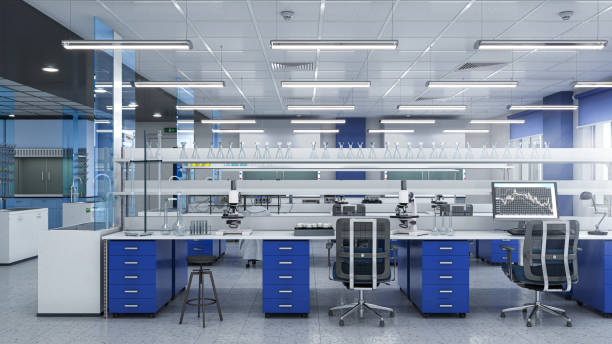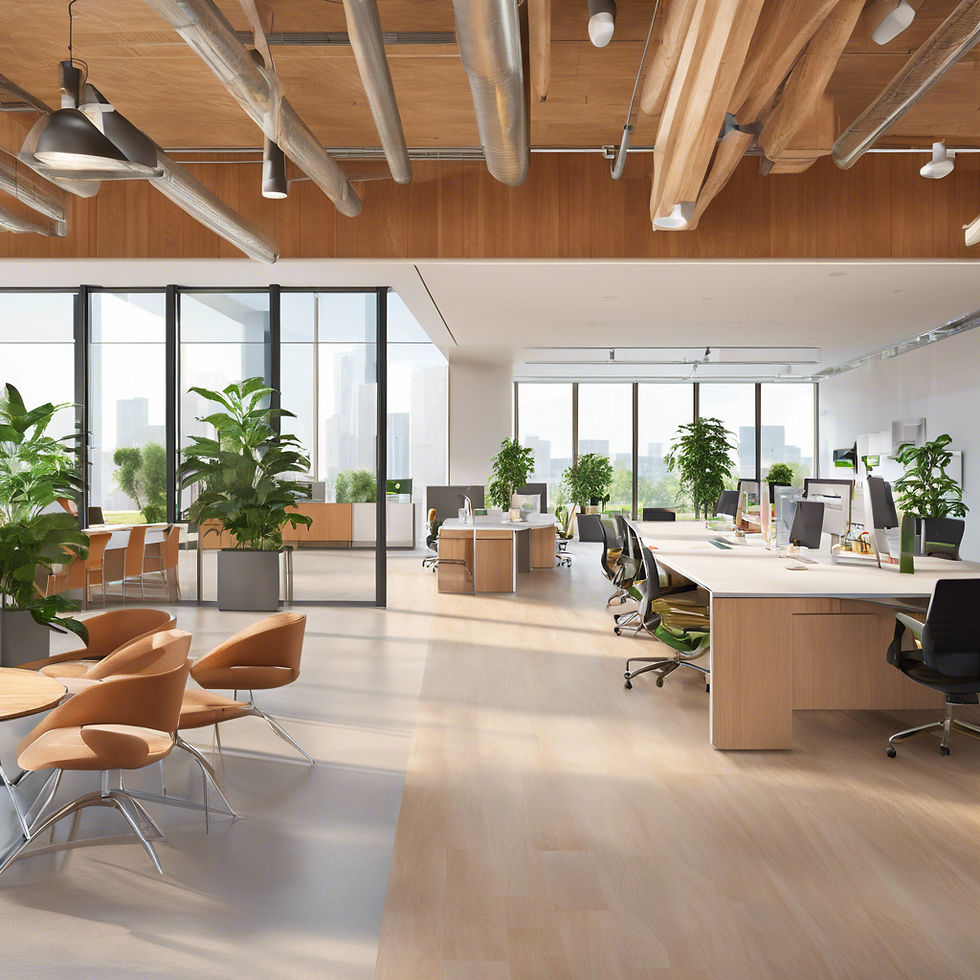How To Interior Design A Perfect Pathology Lab
- Pescora Design

- Jul 11, 2024
- 8 min read
Updated: Jul 17

The interior design of a pathology lab is not just about aesthetics but also about creating an efficient, safe, and comfortable environment for lab personnel and patients. A well-designed space ensures seamless workflow, hygiene, and compliance with industry standards.
How To Interior Design A Perfect Pathology Lab
In this blog, we will explore the essential elements and best practices for designing a pathology lab interior that meets these needs, with a focus on the best materials and brands available in India, including insights from projects by reputed developers like Hiranandani.
Glossary:
Key Considerations for Pathology Lab Interior Design
Before diving into materials and finishes, let’s outline the core principles that commercial interior designers and healthcare architects follow while designing pathology labs:
Infection Control – The space must be designed to minimize contamination through non-porous materials, proper air circulation, and easy-to-clean surfaces.
Ergonomic Layout – The design should allow seamless workflow, keeping sample collection, testing, and administrative areas well-organized.
Safety Compliance – The lab must follow Laboratory Practices guidelines.
Durability & Maintenance – Materials used should be stain-resistant, chemical-resistant, and durable for long-term use.
Flooring
The right flooring is essential for slip resistance, durability, and hygiene maintenance. In pathology labs, floors should be easy to clean, non-porous, and resistant to harsh cleaning agents.

Material
Vinyl Flooring
Vinyl flooring is a popular choice for pathology labs because of its smooth, easy-to-clean surface. It resists moisture, chemicals, and bacteria, making it ideal for healthcare environments. Luxury vinyl tiles (LVT) or sheet vinyl flooring are particularly effective as they offer a seamless installation that prevents dirt and bacteria from accumulating.
🔹 Brands to Consider: Armstrong, Wonderfloor
Epoxy Flooring
Epoxy flooring creates a highly durable, chemical-resistant, and waterproof surface. Its seamless nature eliminates cracks and joints where bacteria could grow. Additionally, anti-slip coatings can be added for extra safety.
🔹 Brands to Consider: Pidilite, Flowcrete

Additional Flooring Considerations
Anti-Slip Coating: Reduces accidents in wet areas.
Light Colors: Helps detect spills and maintain cleanliness.
Cove Base Flooring: Flooring should extend slightly up the walls for better hygiene and easy maintenance.
Ceiling
The Role of Ceilings in a Pathology Lab
The ceiling plays an important role in maintaining indoor air quality, controlling noise levels, and ensuring easy maintenance. Since pathology labs require sterile environments, ceilings should be:
Non-porous and moisture-resistant to prevent mold or bacterial growth.
Easily cleanable to meet hygiene standards.
Integrated with proper lighting and ventilation systems.
Material

Suspended Ceiling Tiles
Suspended ceilings help absorb noise, conceal electrical wiring and HVAC systems, and allow easy replacement of damaged tiles. They are commonly used in Hiranandani commercial healthcare projects for their flexibility and functional benefits.
🔹 Brands to Consider: Armstrong, Saint-Gobain
Cleanroom Ceiling Systems
For high-precision labs, cleanroom ceiling panels offer an anti-microbial, sealed surface that prevents contamination. These are ideal for laboratories handling infectious samples.
🔹 Brands to Consider: Lindner, Plafometal

Additional Ceiling Features
Integrated LED Panels: Ensure consistent, glare-free lighting.
HEPA Filters in Ceilings: Maintain air quality and prevent contamination.
Easy Access Panels: For quick maintenance of electrical and ventilation systems.
Walls
Why Wall Material Selection is Critical?
Pathology labs require walls that are resistant to stains, moisture, and chemicals. Standard wall paints may absorb biological contaminants, leading to hygiene issues. Proper wall materials ensure:
Easy sanitization, reducing contamination risks.
Durability against scratches, stains, and chemicals.
Minimal maintenance, lowering long-term costs.
Material

Epoxy Coated
Epoxy coatings provide a smooth, waterproof, and chemical-resistant surface, preventing microbial growth. These coatings are commonly used in Hiranandani’s medical commercial spaces for their durability and low maintenance.
🔹 Brands to Consider: Pidilite, Berger
Anti-Microbial Paint
Specialized anti-microbial paints prevent the growth of fungi, bacteria, and mold, ensuring long-term hygiene. These paints are also scrub-resistant, allowing frequent cleaning without damage.
🔹 Brands to Consider: Asian Paints, Nippon Paints

Additional Wall Features
Light, Neutral Colors: Improve visibility and create a clean look.
Wall Protection Systems: Use wall guards and corner protectors to prevent damage from lab equipment.
Windows
Why Window Design Matters in Pathology Labs?
Windows in a pathology lab must balance natural light, privacy, and safety. The right windows ensure:
Reduced glare for precise lab work.
Noise insulation, improving the lab’s working environment.
Shatterproof materials to enhance safety.
Type

Double-Glazed
Provides insulation and reduces noise. Saint-Gobain and Fenesta are leading brands in India.
Safety Glass
Ensures protection against breakage. AIS and Guardian Glass are reputable suppliers.
Features
Blinds
Install internal blinds to control light and privacy. Hunter Douglas and MAC provide high-quality options.
Tinted Glass
Consider tinted glass to reduce glare and heat from sunlight. Brands like Saint-Gobain and AIS offer effective solutions.

Doors
Importance of Door Selection in Pathology Labs

Doors in pathology labs must provide secure, easy access while preventing cross-contamination. The ideal door should be:
Smooth and non-porous, for easy cleaning.
Automatic or hands-free, minimizing touchpoints.
Sealed tightly, preventing air leakage.
Type

Automatic Sliding Doors
Enhances accessibility and maintains cleanliness. Dorma and Godrej offer reliable automatic door systems.
Swing Doors
For areas with less traffic, equipped with safety glass panels. Hafele and Dorma are recommended brands.
Features
Hands-Free Operation
Sensor-based or foot-operated doors to reduce contamination. Dorma and Assa Abloy provide advanced solutions.
Sealing
Ensure doors have proper seals to maintain air quality. Products from companies like Geze and Dorma are ideal.
Partitions

Type
Glass Partitions
Glass partitions are ideal for creating separate work areas without obstructing light. Recommended brands include Saint-Gobain and JEB.
Modular Partitions
Modular partitions are flexible and easy to reconfigure as needed. Brands like Hafele and Godrej Interio offer versatile options.

Features
Soundproofing
To reduce noise between different lab sections. Look for soundproof panels from brands like Saint-Gobain and Armstrong.
Integrated Storage
Partitions with built-in storage for maximizing space utilization. Godrej Interio offers innovative solutions.
Furniture

Workstations
Ergonomic Desks and Chairs
Adjustable desks and chairs to accommodate different tasks and reduce strain on staff can be installed in the lab interiors. Herman Miller and Godrej Interio are leading brands.
Anti-Fatigue Mats
Anti-fatigue mats can be placed at workstations where staff stand for long periods. Brands like Notrax and Coba offer durable mats.

Storage
Chemical Storage Cabinets
Ventilated and fire-resistant cabinets for hazardous materials is an essential furniture for a lab. LabGuard and Esco Lifesciences are trusted brands.


Specimen Storage
Refrigerated units for specimens, placed strategically for easy access is a vital interior addition in a pathology lab. Haier and Blue Star provide reliable refrigeration solutions.
Equipment
Lab Benches

Chemical-resistant surfaces with integrated sinks and storage is an important equipment in a pathology lab interior. Brands like LabGuard and Esco Lifesciences offer high-quality lab benches.

Microscopy Stations
Height-adjustable tables and anti-vibration platforms for precision of work is an essential lab equipment. Kewaunee and Esco Lifesciences are recommended.
Lighting Design
Lighting is often overlooked but is one of the most critical aspects of designing a pathology lab. Poor lighting can lead to eye strain, errors in testing, and overall fatigue. The lighting should be tailored to meet the specific tasks performed in each area of the lab.
Types of Lighting:

1. Task Lighting: Bright, focused lighting for precision work areas like microscopy, sample examination, and testing counters. LED task lights reduce shadows and improve accuracy.
2. Ambient Lighting: Uniform overhead lighting ensures visibility throughout the space. Use glare-free diffused LED panels to reduce eye strain.
3. Emergency Lighting: Backup lighting should be integrated to activate during power outages. These include clearly illuminated exit paths and essential workstations.
Brands to Consider: Philips, Wipro Lighting, Bajaj Electricals, Crompton
Additional Tips:
Use dimmable LED panels in multi-use rooms.
Consider motion sensors for storage areas and corridors to save energy.
Opt for color temperatures between 4000K–5000K for optimal visibility in lab environments.
HVAC and Ventilation Systems
Maintaining a controlled internal environment is non-negotiable in a pathology lab. An efficient HVAC (Heating, Ventilation, and Air Conditioning) system ensures air quality, temperature regulation, and contamination control.
Key HVAC Considerations:

1. HEPA Filters: High-Efficiency Particulate Air filters remove contaminants from the air, reducing the risk of infections and preserving specimen integrity.
2. Zoning & Pressure Management: Negative pressure rooms are crucial in biohazard zones to prevent the spread of contaminants. Positive pressure rooms help keep infectious agents out of clean zones.
3. Temperature & Humidity Control: Pathology labs often store sensitive chemicals and specimens. HVAC systems must maintain a consistent temperature and 30–50% relative humidity to protect materials.
Brands to Consider: Daikin, Blue Star, Voltas, Johnson Controls
Additional HVAC Features:
Integrate airflow monitoring systems for real-time feedback.
Use UVGI (Ultraviolet Germicidal Irradiation) systems inside ducts to kill pathogens.
Ensure easy maintenance access to ducts and filters.
Acoustic Treatment
In pathology labs, noise levels from equipment like centrifuges, analyzers, or refrigeration units can cause discomfort and distraction, especially in high-stress environments.
Solutions for Sound Control:

1. Acoustic Ceiling Tiles: Install mineral fiber or fiberglass ceiling tiles that absorb sound. This reduces echo and ambient noise in work areas.
2. Wall Panels and Flooring Underlays: Add acoustic panels to walls and underlayers beneath flooring materials to minimize noise transmission between rooms.
3. Soundproof Partitions: Use double-glazed glass partitions with sound insulation between testing and administrative zones.
Brands to Consider: Saint-Gobain Ecophon, Armstrong, Rockfon
Rooms

Common Areas
Break Rooms
Comfortable seating, tables, and kitchen facilities for staff relaxation are essential in a break room. Brands like Godrej Interio and IKEA offer practical solutions for break rooms.
Meeting Rooms
Meeting rooms must be equipped with whiteboards, projectors, and conference tables for team meetings and discussions. Herman Miller and Steelcase are reliable brands to shop for the same.
Specialized Areas

Clean Rooms
For handling sensitive specimens, with controlled environments and strict access protocols, clean rooms interior must be efficient. Cleanroom systems from brands like Esco Lifesciences and Bluestar provide high standards.
Isolation Areas
For handling infectious materials, with negative pressure ventilation and strict containment measures, isolation areas in a pathology lab are important. Products from companies like Esco Lifesciences and Kewaunee are ideal.
Conclusion:

Leading healthcare projects, such as those by Hiranandani, prioritize hygienic materials, efficient layouts, and long-lasting finishes in pathology labs. By incorporating seamless flooring, anti-microbial coatings, high-quality ventilation, and ergonomic furniture, designers can create safe, efficient, and future-ready laboratory spaces.
FAQs:
How can sustainability be incorporated into the design of a pathology lab?
Energy-Efficient Systems:
Use LED lighting and energy-efficient HVAC systems.
Install motion sensors to reduce energy consumption.
Sustainable Materials:
Choose eco-friendly construction materials (e.g., recycled content).
Use low-VOC paints and finishes.
Waste Reduction:
Implement recycling programs for non-hazardous waste.
Minimize single-use plastics and encourage reusable alternatives.
What are the best practices for waste management in a pathology lab?
Segregation:
Separate hazardous from non-hazardous waste.
Use color-coded bins for different types of waste.
Proper Disposal:
Follow local regulations for medical waste disposal.
Contract with certified waste disposal companies.
Training:
Train staff on proper waste segregation and disposal methods.
Conduct regular audits to ensure compliance.
How can technology integration enhance the efficiency of a pathology lab?
Automated Systems:
Implement automated sample processing equipment.
Use barcode systems for sample tracking.
Digital Record Keeping:
Adopt electronic medical records (EMR) systems.
Utilize cloud-based solutions for easy access and backup.
Data Management:
Integrate laboratory information management systems (LIMS).
Use data analytics for improving workflow and decision-making.
What are the considerations for emergency preparedness in a pathology lab?
Emergency Exits:
Ensure exits are clearly marked and unobstructed.
Conduct regular checks to keep exits functional.
Emergency Equipment:
Keep first aid kits, fire extinguishers, and spill kits accessible.
Regularly inspect and maintain emergency equipment.
Staff Training:
Train staff on emergency procedures and equipment use.
Conduct regular emergency drills and simulations.
How should a pathology lab be designed to handle biohazards safely?
Containment Areas:
Designate specific zones for handling biohazards, with restricted access.
Install negative pressure rooms to prevent the spread of contaminants.
Safety Equipment:
Equip these areas with biosafety cabinets and autoclaves.
Ensure proper disposal systems for biohazardous waste.
Protective Barriers:
Use partitions and protective screens to separate biohazard zones from general areas.
Implement hands-free operation for doors in these areas to reduce contamination.



Comments